If you’re thinking about creating a pollinator garden, you’ve probably already considered the best flowers for bees and butterflies, and you may already have a pollination-friendly tree or two. But if you’re looking for a foundation plant to pull your pollinator garden together, you’ll find the best shrubs for pollinators in the list below.
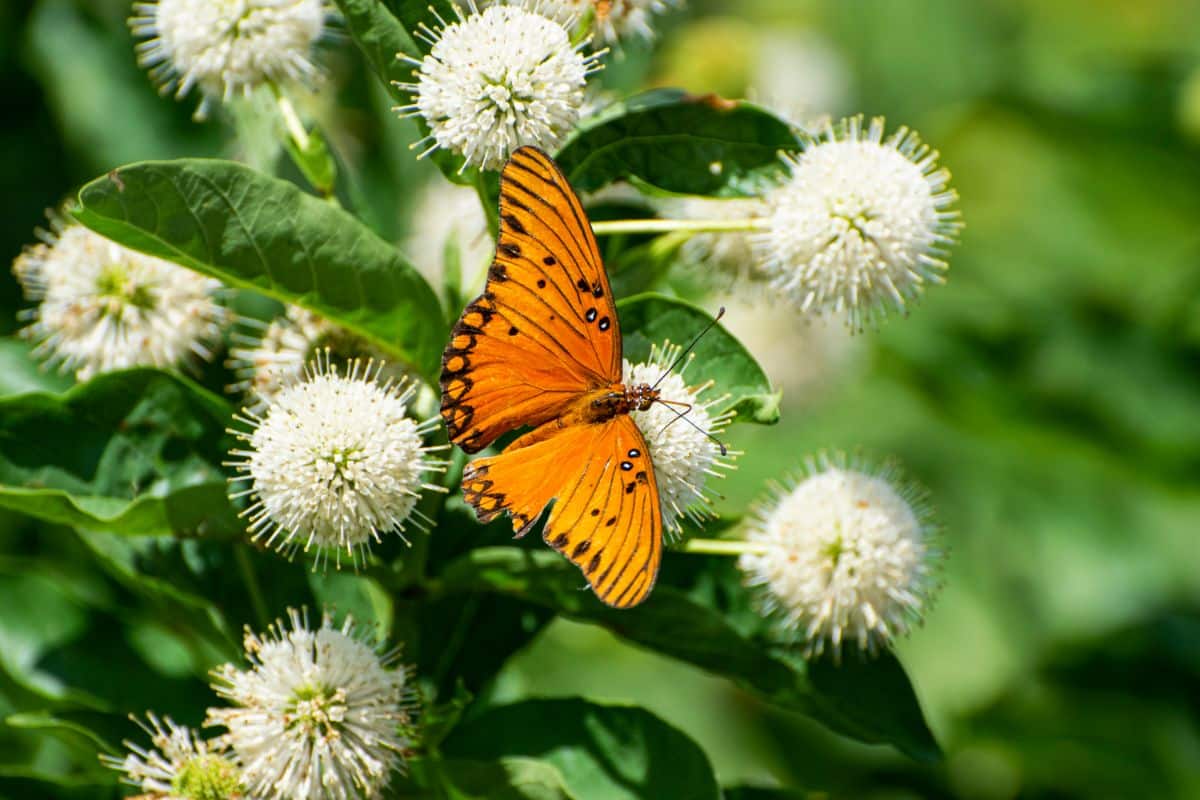
These shrubs are all attractive enough to be used in ornamental gardens, but they offer benefits for pollinators as well. Some of these shrubs produce nectar and pollen-rich flowers or edible berries that bees, butterflies, and birds won’t be able to resist. Other shrubs on this list are useful host plants for caterpillars and other beneficial insects, and they provide shelter for wildlife too!
Jump to:
- 18 best shrubs to grow in a pollinator garden
- 1. Buttonbush (Cephalanthus occidentalis)
- 2. Serviceberry (Amelanchier spp.)
- 3. Ninebark (Physocarpus spp.)
- 4. Beach Rose (Rosa rugosa)
- 5. Purple Flowering Raspberry (Rubus odoratus)
- 6. Summersweet (Clethra alnifolia)
- 7. Rose of Sharon (Hibiscus syriacus)
- 8. Viburnum (Viburnum spp.)
- 9. Shrubby St. John’s Wort (Hypericum prolificum)
- 10. Elderberry (Sambucus spp.)
- 11. Spirea (Spirea spp.)
- 12. Hydrangea (Hydrangea spp.)
- 13. Shrubby Cinquefoil (Potentilla fruticosa)
- 14. Fragrant sumac (Rhus aromatica)
- 15. Leadplant (Amorpha canescens)
- 16. Butterfly bush (Buddleja spp.)
- 17. Blueberry (Vacciniumspp.)
- 18. Chokecherry (Prunus virginiana)
- Summary
18 best shrubs to grow in a pollinator garden
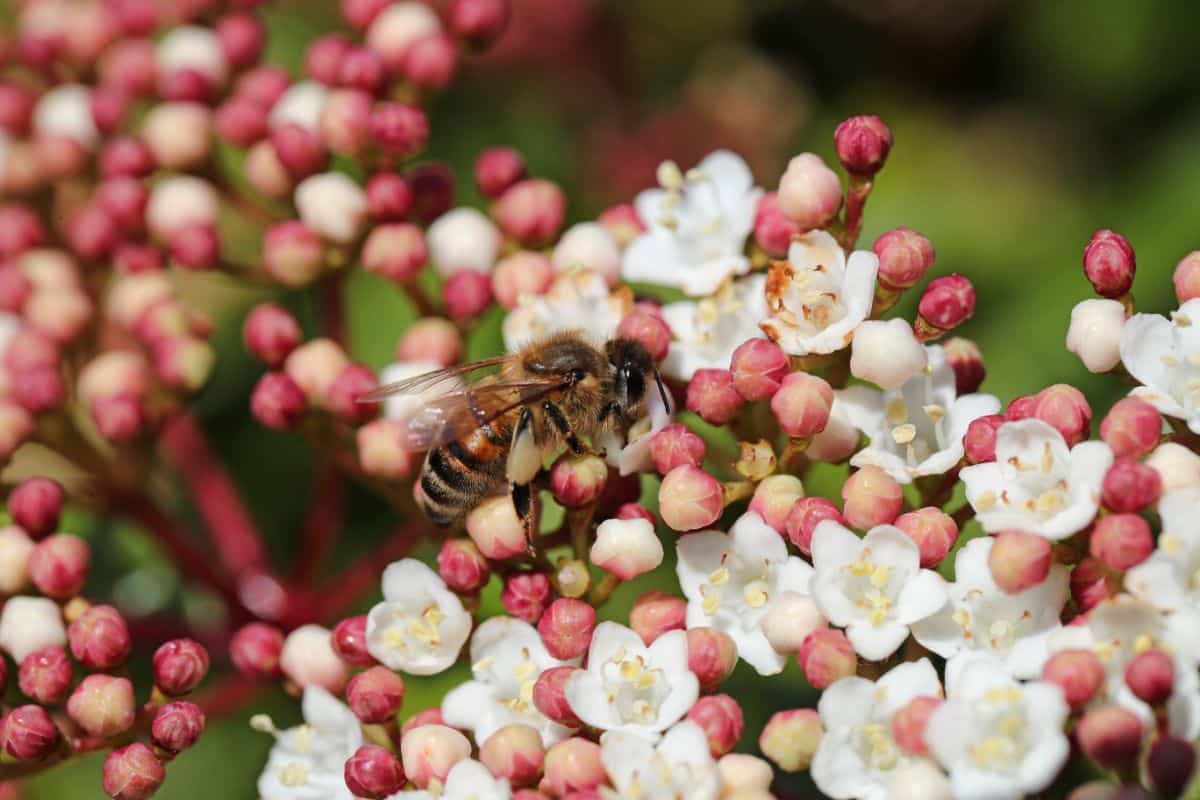
If you want to create a multi-leveled planting arrangement that can rival any professional landscape design, it’s important to choose plants with different heights, textures, and colors. Layering tall trees with shrubs and shorter ornamentals will create a more complex garden look. Plus, if you choose the right plants, you can also attract even more pollinators!
1. Buttonbush (Cephalanthus occidentalis)
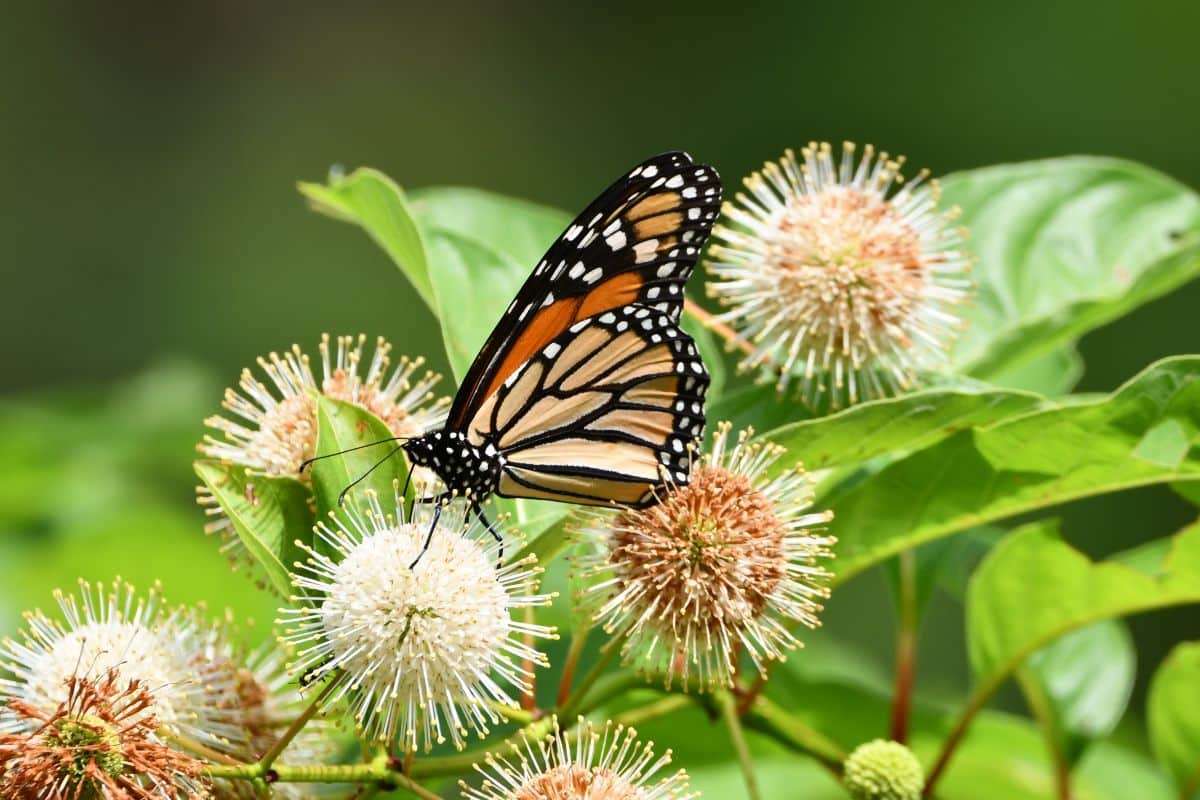
| Plant name: | Buttonbush |
| Light requirements: | Full sun to part shade |
| Water requirements: | High |
| Growing zone: | Zones 5 to 11 |
| Bloom time: | Summer to early fall |
One of the best pollinator shrubs around, the buttonbush has distinct, ball-shaped flowers that are a creamy white color. When the flowers bloom around the end of summer, they’ll lure butterflies and other pollinators to your garden. These plants also produce seeds that are an important food source for songbirds and waterfowl.
Buttonbush is native to Central and North America, where it’s commonly found growing in wetlands and along stream banks. In backyard gardens, buttonbush will grow happily in poorly draining soil, and it’s also suitable for planting near water features. Full-grown plants grow between 6 and 10’ tall, and their dense leaves provide a safe nesting spot for birds!
2. Serviceberry (Amelanchier spp.)
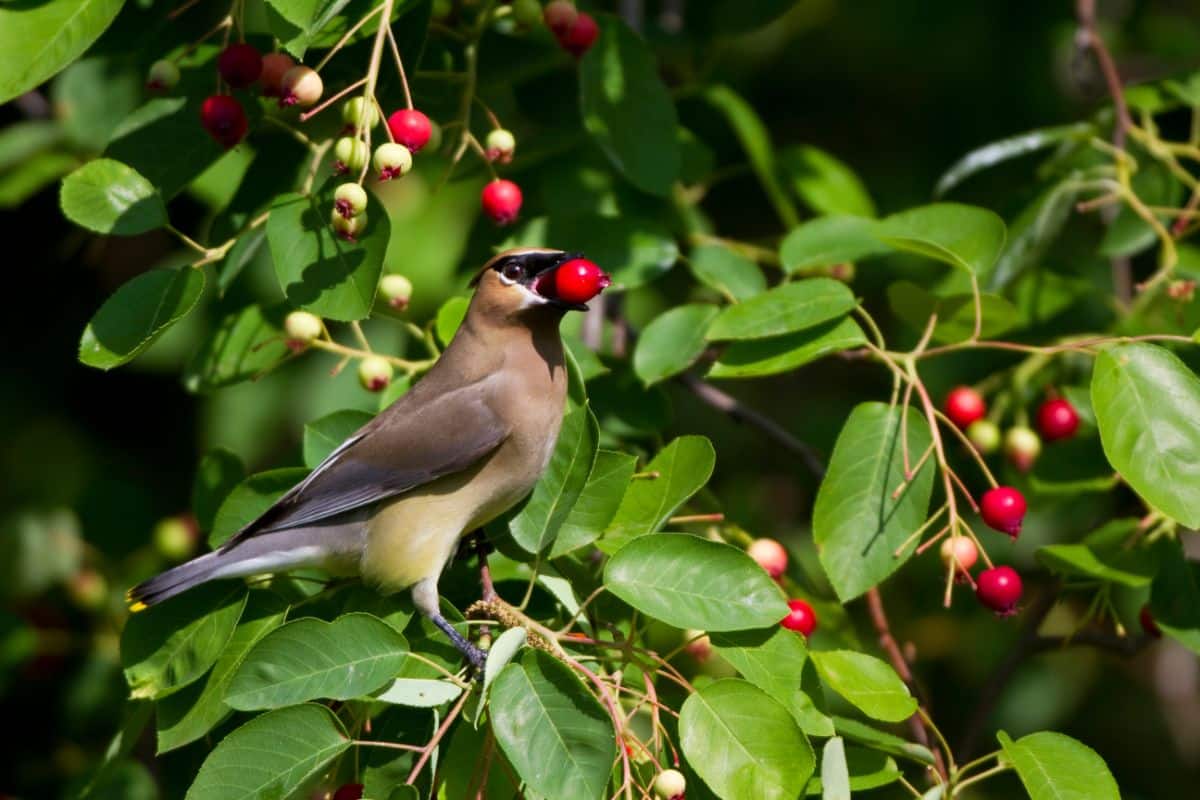
| Plant name: | Serviceberry |
| Light requirements: | Full sun |
| Water requirements: | Moderate to low |
| Growing zone: | Zones 4 to 9 |
| Bloom time: | Early spring |
Also known as shadbushes, Saskatoon berries, and juneberries, serviceberry shrubs provide year-round interest, making these bushes ideal foundation plants for any garden. But if your goal is to attract pollinators, serviceberries are always a fine choice. These shrubs are host plants for various species of butterflies, including the Viceroy butterfly and the Canadian swallowtail, and their early flowers provide pollen for insects long before other flowers emerge.
There are about 20 different species of serviceberries, and most of them are native to North America. Full-grown plants grow between 10 and 25’ tall, and their handsome leaves turn into brilliant shades of orange and red in autumn. If you needed even more reasons to love serviceberries, they produce edible berries that taste like a mix of blackberries and blueberries.
3. Ninebark (Physocarpus spp.)

| Plant name: | Ninebark |
| Light requirements: | Full sun to part shade |
| Water requirements: | Moderate to low |
| Growing zone: | Zones 3 to 7 |
| Bloom time: | Late spring to early summer |
Native to North America, ninebark is a member of the rose family, and it’s been cultivated as an ornamental for years. Thanks to the careful breeding practices of plant enthusiasts, you can find many varieties of ninebark today, including cultivars with particularly vivid autumn foliage. Most varieties of ninebark grow between 5 and 10’ tall, and you can find cultivars with dark purple, chartreuse, red, or deep green leaves.
Ninebark is famously a winter interest plant, known for its peeling bark and strong silhouette. But ninebark is also a useful pollinator plant that produces clusters of white to pink flowers in spring that provide nectar and pollen to wasps, bees, butterflies, and more. Ninebark is also a valuable host plant for some species of beetles and moths.
4. Beach Rose (Rosa rugosa)
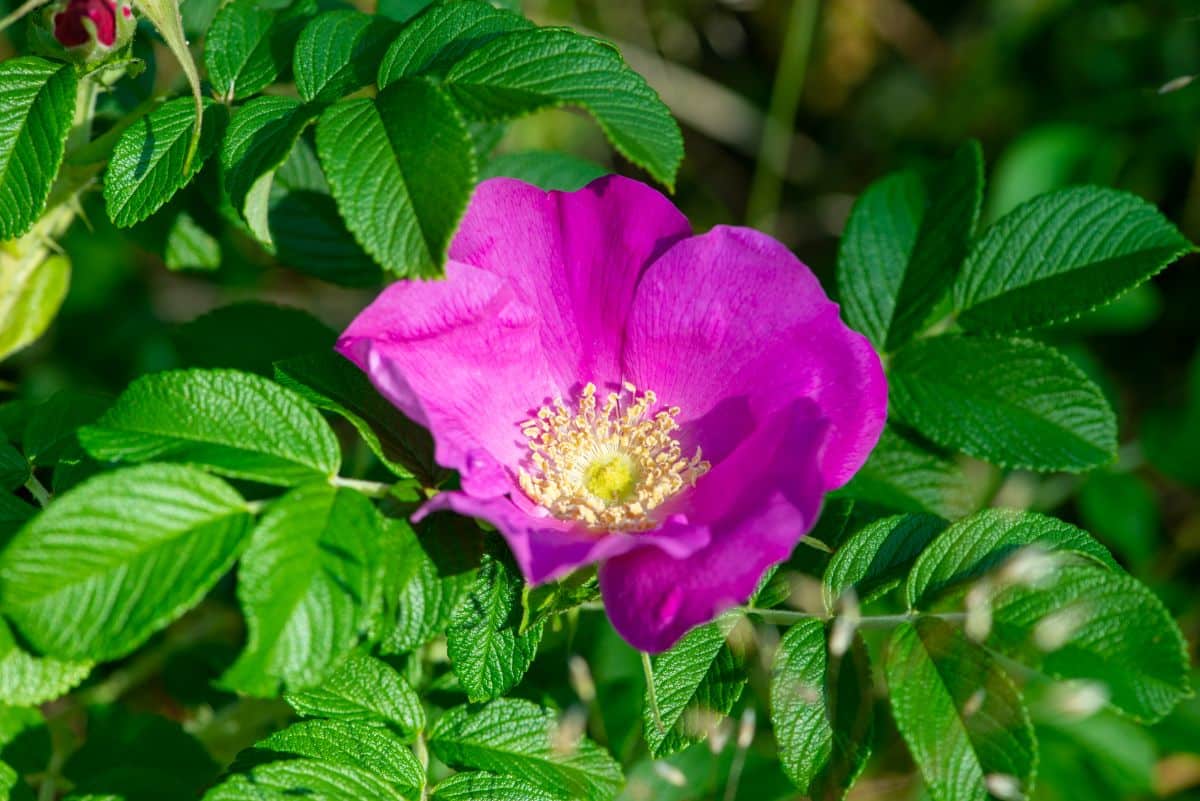
| Plant name: | Beach rose |
| Light requirements: | Full sun |
| Water requirements: | Moderate to low |
| Growing zone: | Zones 2 to 7 |
| Bloom time: | Late spring to summer |
As long as you grow roses organically, most varieties of roses can benefit pollinators in some way. But if you want to take your pollinator garden to the next level, one of the best rose varieties you can keep is the beach rose. This common rose type is often found growing wild in beachy areas, but it also thrives as an ornamental in garden beds.
Beach roses grow about 5 to 6’ tall, and they have big, open flowers that are easy for pollinators of all sorts to feed from. Beach roses generally bloom in mid-summer, and their petals range in hue from white to pink. After their flowers fade, beach roses produce a profusion of edible rosehips that are rich in vitamin C and make a tasty herbal tea or sweet jam.
5. Purple Flowering Raspberry (Rubus odoratus)
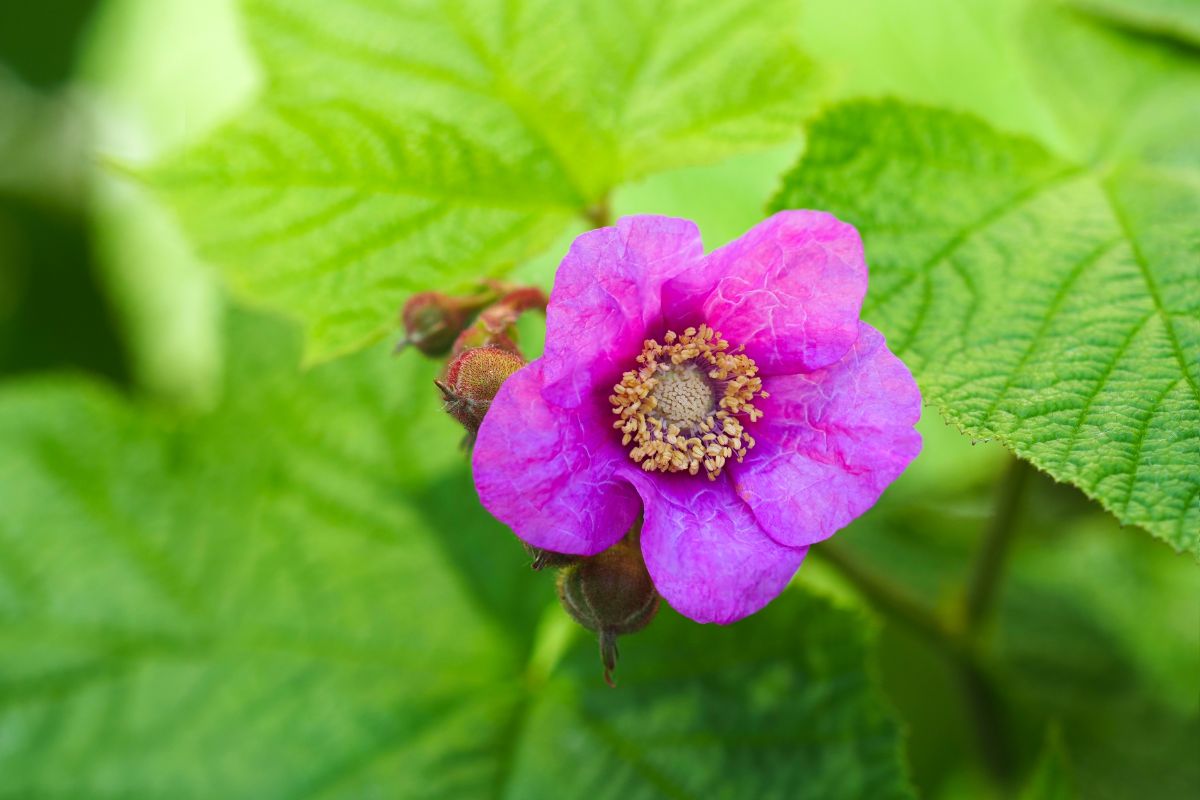
| Plant name: | Purple flowering raspberry |
| Light requirements: | Full sun to shade |
| Water requirements: | Moderate |
| Growing zone: | Zones 3 to 8 |
| Bloom time: | Summer |
All raspberries are beneficial to pollinators, and you can grow a patch of edible raspberries and enjoy the hum of bees and other insects that come to visit them. But if you’re trying to attract the most pollinators to your garden, one of the best raspberry varieties you can keep is the purple flowering raspberry. This raspberry produces edible berries, but they aren’t quite as delicious as other raspberry types, so this plant is mostly kept as an ornamental.
Purple flowering raspberry has a long bloom time, and its flowers generally last throughout the summer months. Those big, pinkish-purple flowers look a lot like the blooms of beach roses, and they’re equally attractive to native bees and other wildlife. Native bees also often use purple flowering raspberries for nesting materials, and this plant’s edible berries are greedily gobbled up by wild birds too.
6. Summersweet (Clethra alnifolia)

| Plant name: | Summersweet |
| Light requirements: | Full sun to shade |
| Water requirements: | Moderate |
| Growing zone: | Zones 4 to 9 |
| Bloom time: | Mid-to-late summer |
Also known as the sweet pepperbush, summersweet is a deciduous shrub that’s often kept as a specimen plant. Growing between 6 and 12’ tall, summersweet is native to North America, and it’s often found growing in poor, sandy soils in the wild. But if you have a garden with very sandy earth, summersweet should grow there well too!
Summersweet tolerates anything from full sun to shade, allowing you to plant this shrub in almost any area of your garden. Blooming late in summer, summersweet produces long spikes of flowers that are fragrant and come in delightful shades of pink and white. Songbirds, hummingbirds, bees, and butterflies all love summersweet, and certain moth species use it as a host plant as well.
7. Rose of Sharon (Hibiscus syriacus)
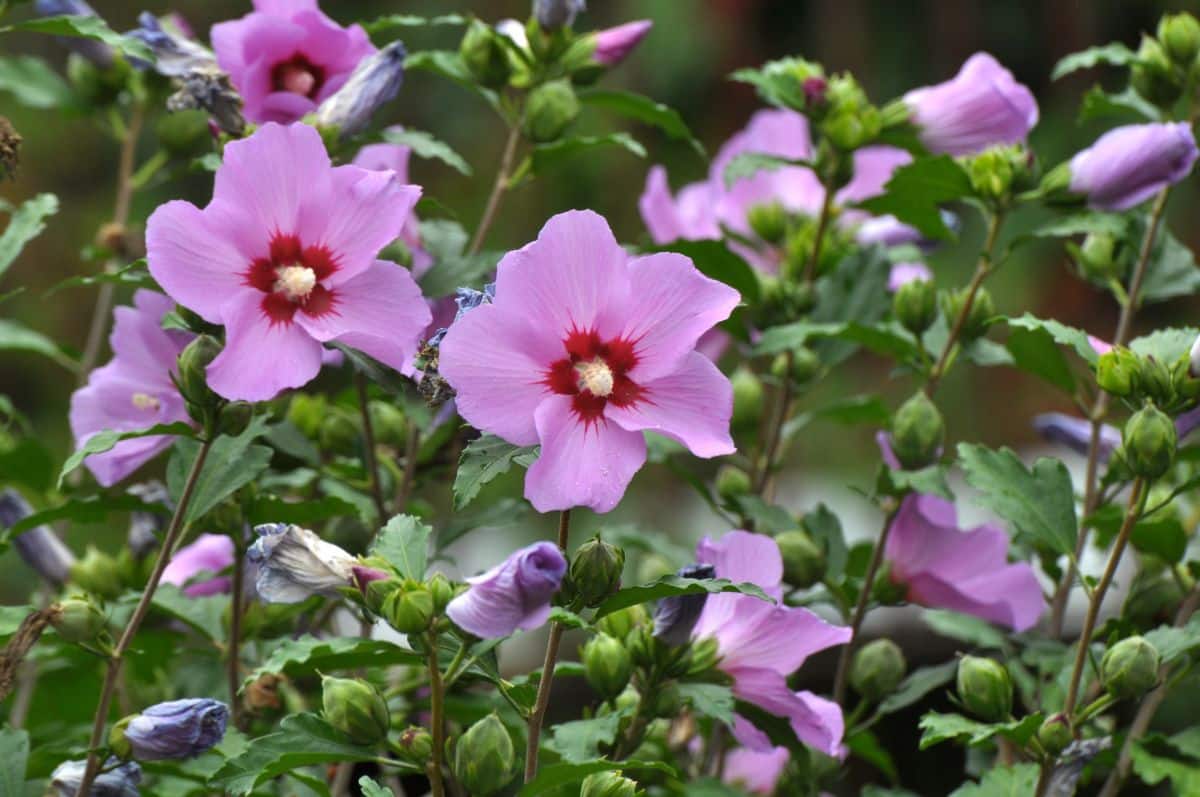
| Plant name: | Rose of Sharon |
| Light requirements: | Full sun to part shade |
| Water requirements: | Moderate to low |
| Growing zone: | Zones 5 to 9 |
| Bloom time: | Mid-summer to fall |
Rose of Sharon is a variety of hibiscus that’s native to Asia, although it’s a common landscaping plant in other parts of the world. Like other hibiscus plants, the rose of Sharon produces large, open flower faces that look very tropical and come in an assortment of playful colors. This plant is also edible, and its flowers make a delicious tea, although they can be used in other ways too.
Hummingbirds are particularly captivated by rose of Sharon blooms, but beneficial insects adore these plants as well. Rose of Sharon grows up to 12’ tall, making it a solid choice for planting towards the back of garden beds, although it can also hold its own as a specimen plant. For an even more impressive look, you can plant rose of Sharon shrubs in a line and form a colorful living hedge that will provide extra garden privacy!
8. Viburnum (Viburnum spp.)
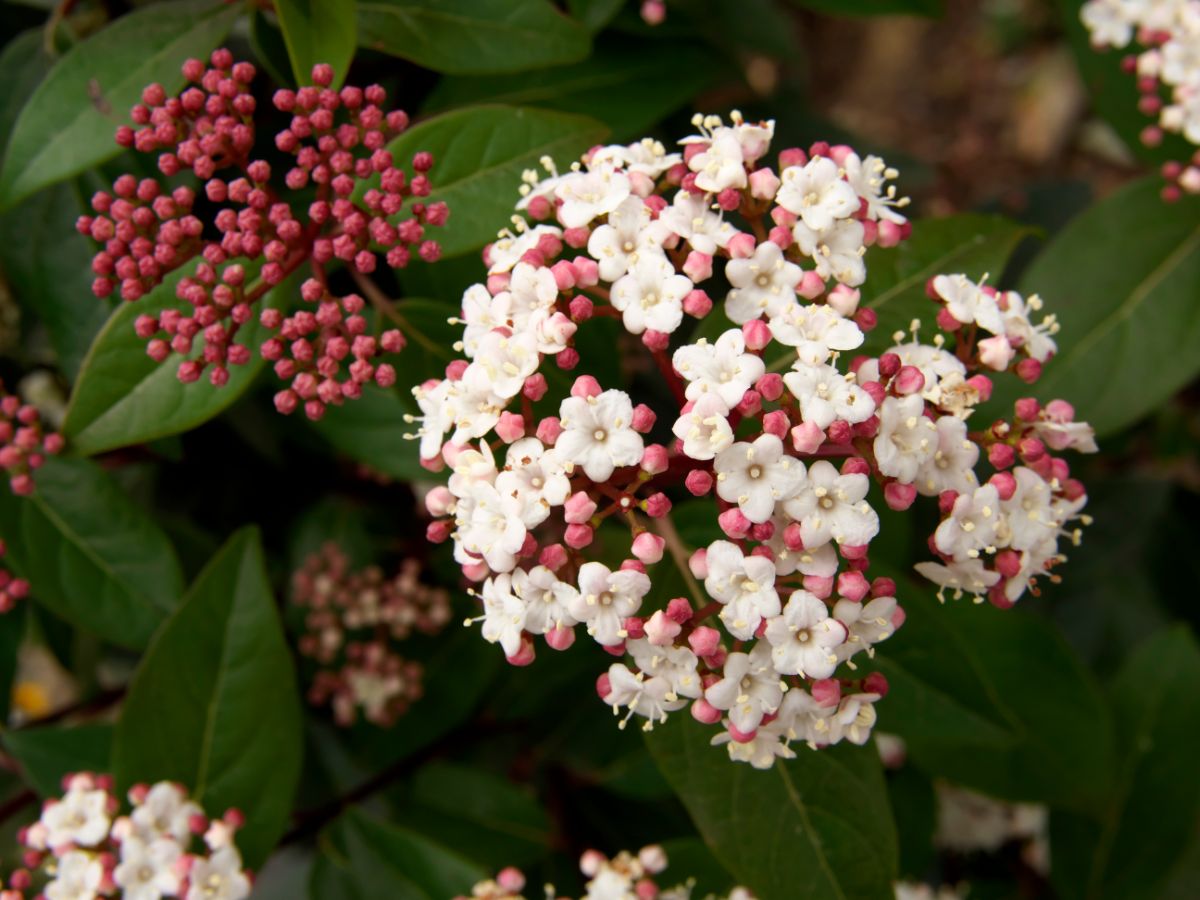
| Plant name: | Viburnum |
| Light requirements: | Full sun to part shade |
| Water requirements: | Moderate to low |
| Growing zone: | Zones 2 to 9 |
| Bloom time: | Early spring to early summer |
There are between 150 and 175 different species of viburnum in the world, many of which are native to North America and Asia. This plant family includes popular ornamentals like the snowball bush viburnum, but varieties like the blackhaw viburnum (Viburnum prunifolium) are particularly beneficial for pollinators. Viburnums are mostly known for their clusters of white or pink flowers that bloom from spring to early summer, but these plants also produce colorful berries in autumn.
Viburnums can grow in full sun or part shade, and they are generally quite pest resistant; however, these plants can be vulnerable to the viburnum leaf beetle. Depending on the variety, viburnums can grow between 3 and 20’ tall. If you have a small space or container garden, try out dwarf viburnum species like Lil’ Ditty.
9. Shrubby St. John’s Wort (Hypericum prolificum)

| Plant name: | Shrubby St. John’s Wort |
| Light requirements: | Full sun to part shade |
| Water requirements: | Moderate |
| Growing zone: | Zones 3 to 8 |
| Bloom time: | Summer |
Most gardeners are familiar with perforate St. John’s wort, which is a small ornamental plant that’s always a hit with pollinators. But the St. John’s wort family is a large one, and it contains over 500 different species of plants that range in size from small ornamentals to large shrubs. Shrubby St. John’s wort is one popular option that’s easy to find and ideal for pollinator gardening.
Growing up to 6’ tall, shrubby St. John’s wort has the same sunshine yellow flowers that we expect from St. John’s wort plants, and it’s also undemanding. This plant grows as a native throughout North America, and it’s commonly found along the margins of swamps and woodlands. Bumble bees are particularly fond of shrubby St. John’s wort, but honeybees frequent it as well.
10. Elderberry (Sambucus spp.)
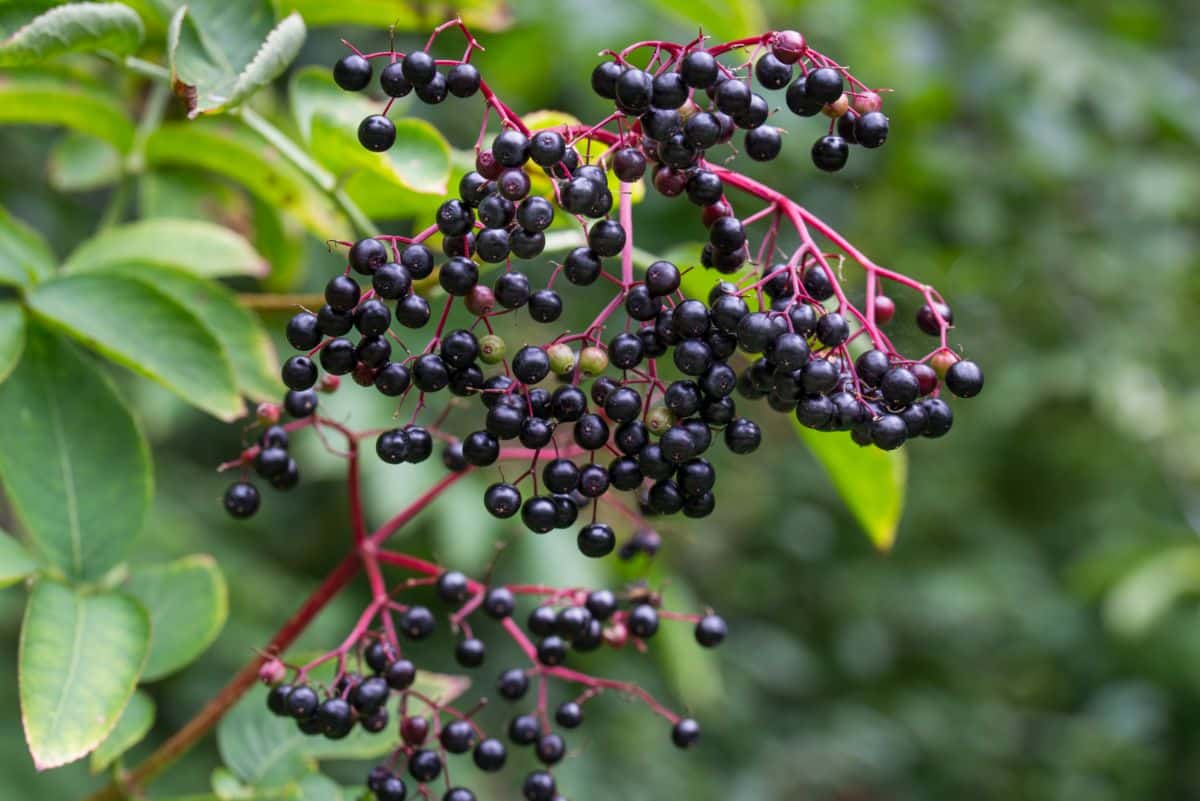
| Plant name: | Elderberry |
| Light requirements: | Full sun |
| Water requirements: | Moderate |
| Growing zone: | Zones 3 to 7 |
| Bloom time: | Spring to mid-summer |
Elderberry is mostly known for its berries that can be cooked into medicinal syrup or used in jams. But elderberry shrubs are also fantastic pollinator plants, and they’re showy enough for ornamental gardens too. Elderberries are mostly pollinated by bees, but they’re also an essential host plant for various species of moths and butterflies, including the cecropia moth, which is the largest moth in North America.
Elderberries bloom white clusters of fragrant flowers in spring to summer, and the plant’s decadent floral aroma will lend a magical feel to any garden. By autumn, those flowers mature into dark purple berries that should be harvested quickly if you don’t want the birds to get to them first! Keep in mind that elderberries should be cooked, fermented, or heat treated to avoid stomach and gastrointestinal upset.
11. Spirea (Spirea spp.)

| Plant name: | Spirea |
| Light requirements: | Full sun to part shade |
| Water requirements: | Moderate |
| Growing zone: | Zones 3 to 9, depending on a variety |
| Bloom time: | Spring to summer, depending on a variety |
Also known as meadowsweet or steeplebush, spirea is another common landscaping plant that’s mostly grown for its vibrant flowers and leaves. Spirea flowers come in a range of shades, including pink, white, purple, and red, and many emit a sweet, floral fragrance that’s particularly bewitching on a hot summer night. Depending on the variety, spirea can bloom from spring through summer, and then the plant will continue to delight with its color-changing autumn foliage.
Spirea are generally deer and rabbit resistant, but their flowers are irresistible to insects of all sorts, as well as hummingbirds. Spirea can grow between 2 and 10’ tall, and the smaller dwarf varieties are the perfect size for a container garden. One of the most famous spirea varieties is the bridal wreath spirea, which produces an explosion of long and cascading flowers in spring.
12. Hydrangea (Hydrangea spp.)
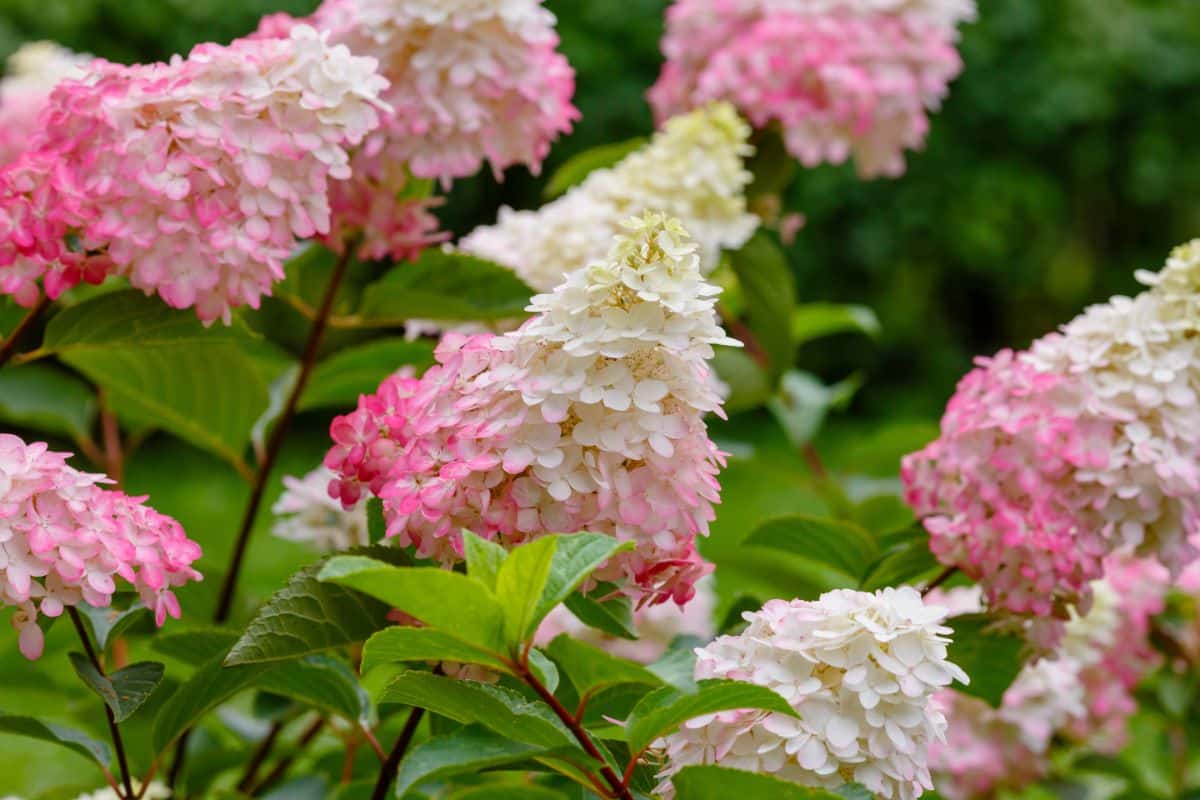
| Plant name: | Hydrangea |
| Light requirements: | Full sun to part shade |
| Water requirements: | Moderate |
| Growing zone: | Zones 3 to 9, depending on a variety |
| Bloom time: | Mid-spring to early fall |
Every garden needs a hydrangea bush or two. Hydrangeas pack a punch in planting arrangements with their oversized blooms that come in an assortment of colors. Some hydrangeas have creamy white blooms that show up beautifully in moon gardens, while other hydrangeas have color-changing flowers that shift shades depending on the pH of the soil.
Many different hydrangea types will benefit pollinators, but one of the best varieties you can grow in a wildlife habitat is the panicle hydrangea (Hydrangea paniculata). The French hydrangea, on the other hand, doesn’t produce pollen, so it’s less beneficial to bees and other insects. Panicle hydrangeas are also more winter-hardy than most other hydrangea types, and they can thrive in areas as cool as Zone 3.
13. Shrubby Cinquefoil (Potentilla fruticosa)
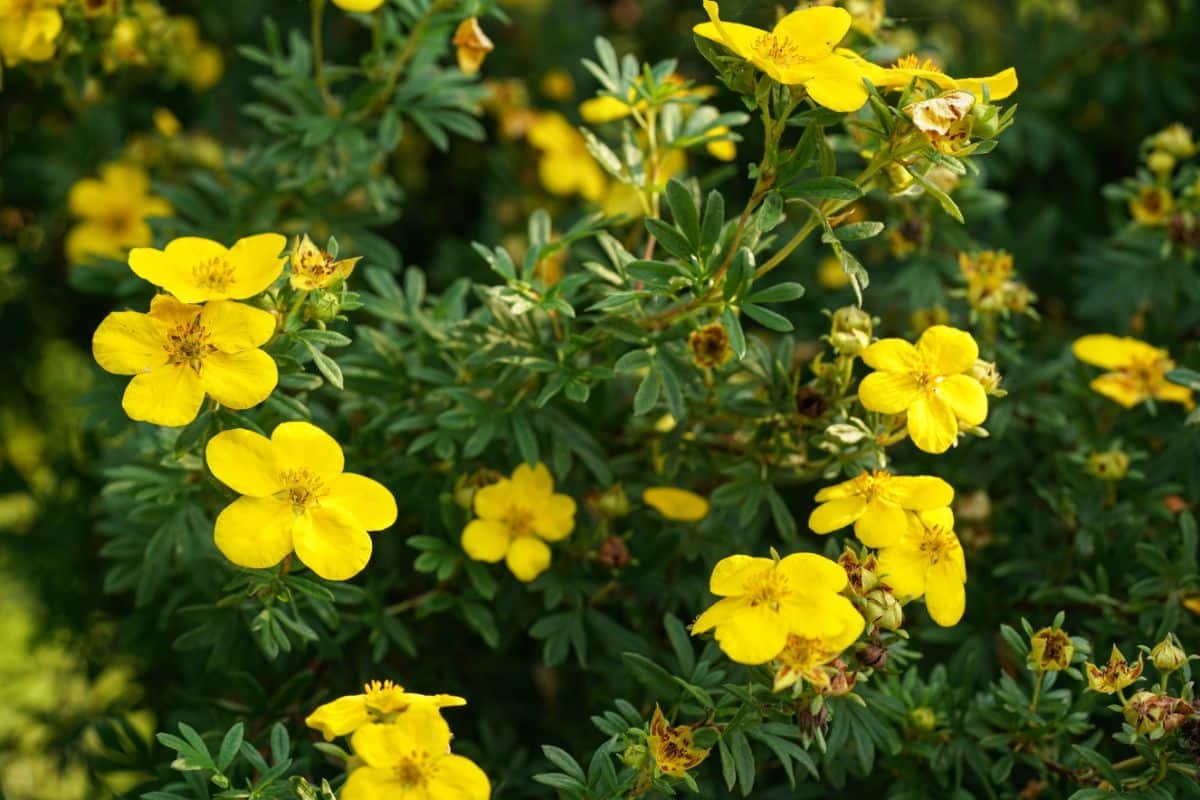
| Plant name: | Shrubby cinquefoil |
| Light requirements: | Full sun to part shade |
| Water requirements: | Moderate to low |
| Growing zone: | Zones 3 to 7 |
| Bloom time: | Summer to early fall |
Like St. John’s wort, cinquefoil is a large plant family that contains over 300 different species of plants. Within that family, you can find small ornamentals, creeping groundcovers, and taller shrubs too. The shrubby cinquefoil is one of the larger options, and it grows between 2 and 4’ tall when mature.
Cinquefoils are closely related to roses, and you can see that in their finely structured flowers. Shrubby cinquefoil blooms from early summer to early fall, and its flowers come in a buttery yellow color that can’t help but delight you and pollinators too! Once established, shrubby cinquefoil is a very low-maintenance plant, and it’s an excellent food source for native bees, as well as a host plant for various butterflies and moths.
14. Fragrant sumac (Rhus aromatica)
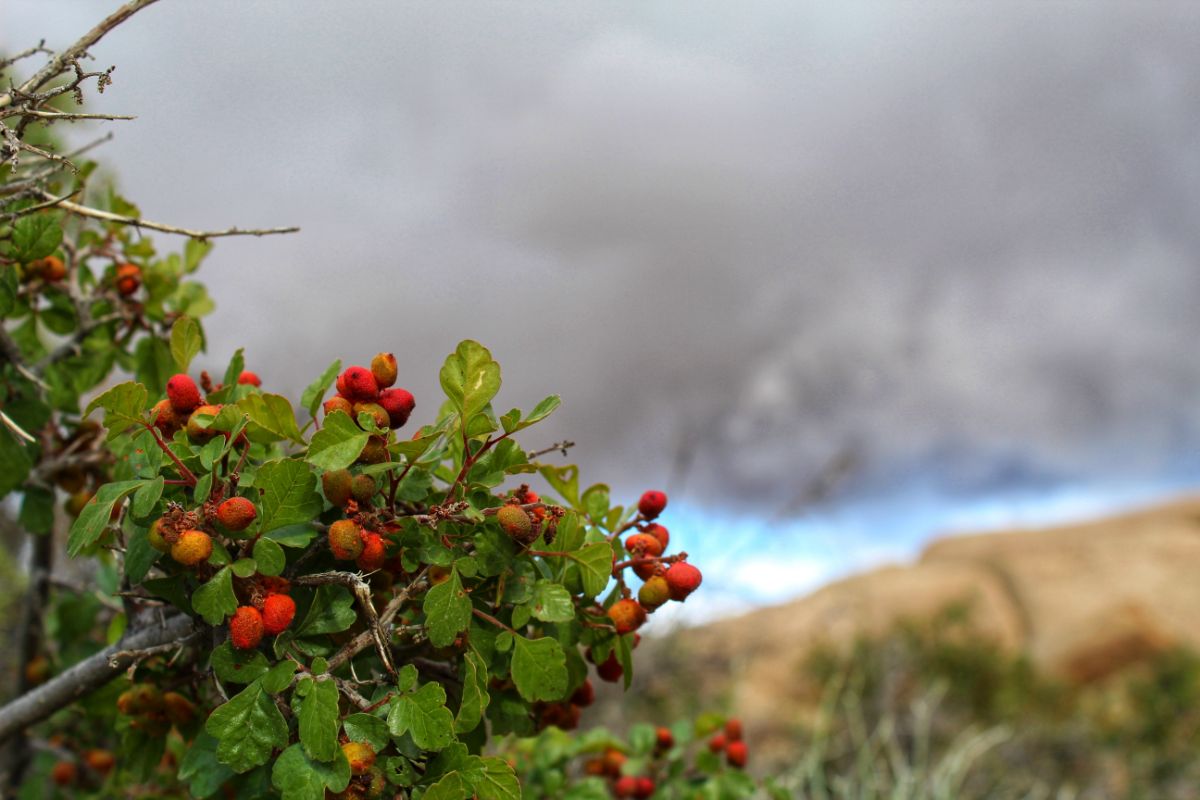
| Plant name: | Fragrant sumac |
| Light requirements: | Full sun to part shade |
| Water requirements: | Moderate |
| Growing zone: | Zones 3 to 9 |
| Bloom time: | Early spring |
Native to Central and North America, fragrant sumac is a low-growing, rambling shrub that is particularly good for growing on hillsides or anywhere else where erosion control is needed. But this plant is also perfectly suited for pollinators, and its early spring flowers provide food for bees before most other plants wake up after their winter snooze. Fragrant sumac also yields masses of berries in late summer to fall, which can last through the winter and serve as a food source for birds.
Unlike poison sumac, fragrant sumac won’t cause any rashes or unpleasantness if you brush up against it. But what it does do is emit a pleasing fragrance that smells a bit like lemons when its leaves or stems are crushed. Adaptable to both sun and part shade, fragrant sumac thrives in well-draining gardens, and it can even handle acidic soil types.
15. Leadplant (Amorpha canescens)
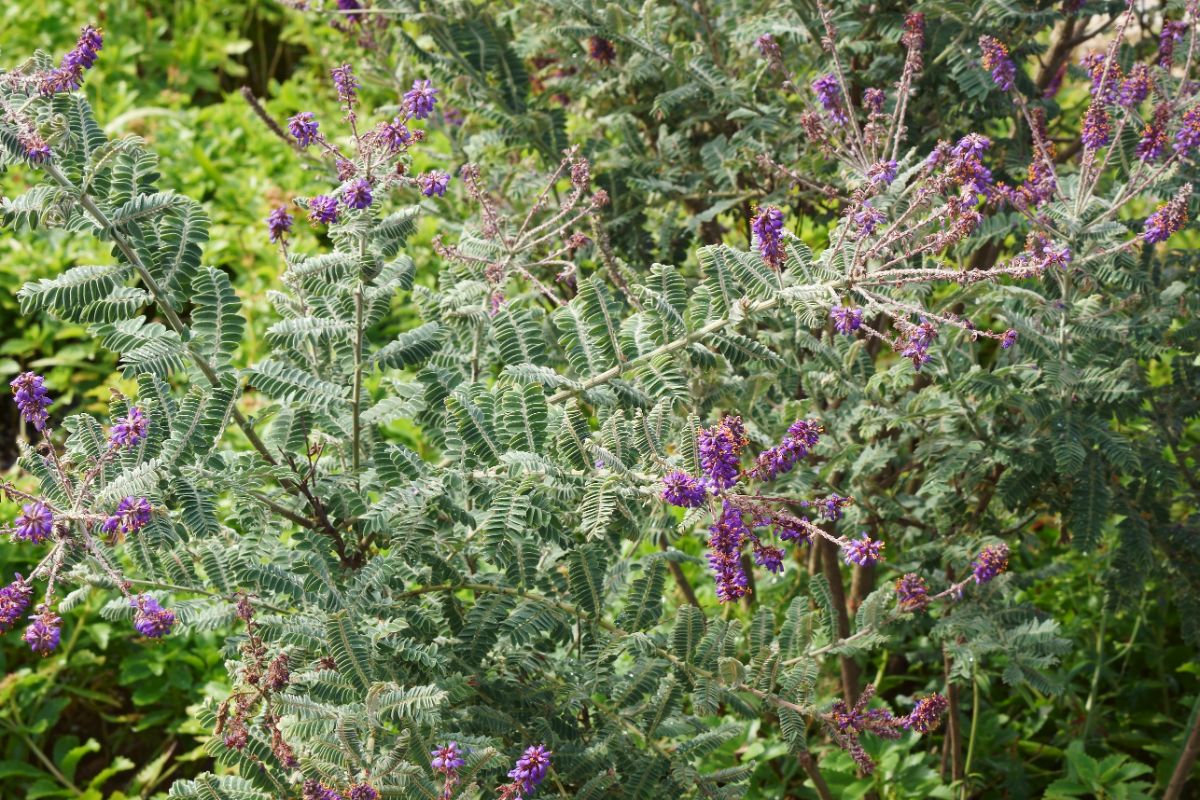
| Plant name: | Leadplant |
| Light requirements: | Full sun |
| Water requirements: | Moderate to low |
| Growing zone: | Zones 3 to 8 |
| Bloom time: | Summer |
Leadplant is another North American native that can be grown in ornamental gardens or pollinator habitats. This small semi-shrub is slow to grow, and it maxes out at around 3’ tall, but what it lacks in size, it more than makes up for in flowers. Leadplant blooms in early summer, producing long spires of purple flowers that yield a feast of nectar for butterflies, bees, beetles, and other wildlife.
Leadplant gets its name from the silvery-gray hairs on its leaves, which are slightly reminiscent of the color of raw lead. This plant is a larval host for various insects, including the dogface sulphur butterfly. As it grows, leadplant develops an extensive root system that the plant uses to access water deep in the soil in times of drought.
16. Butterfly bush (Buddleja spp.)
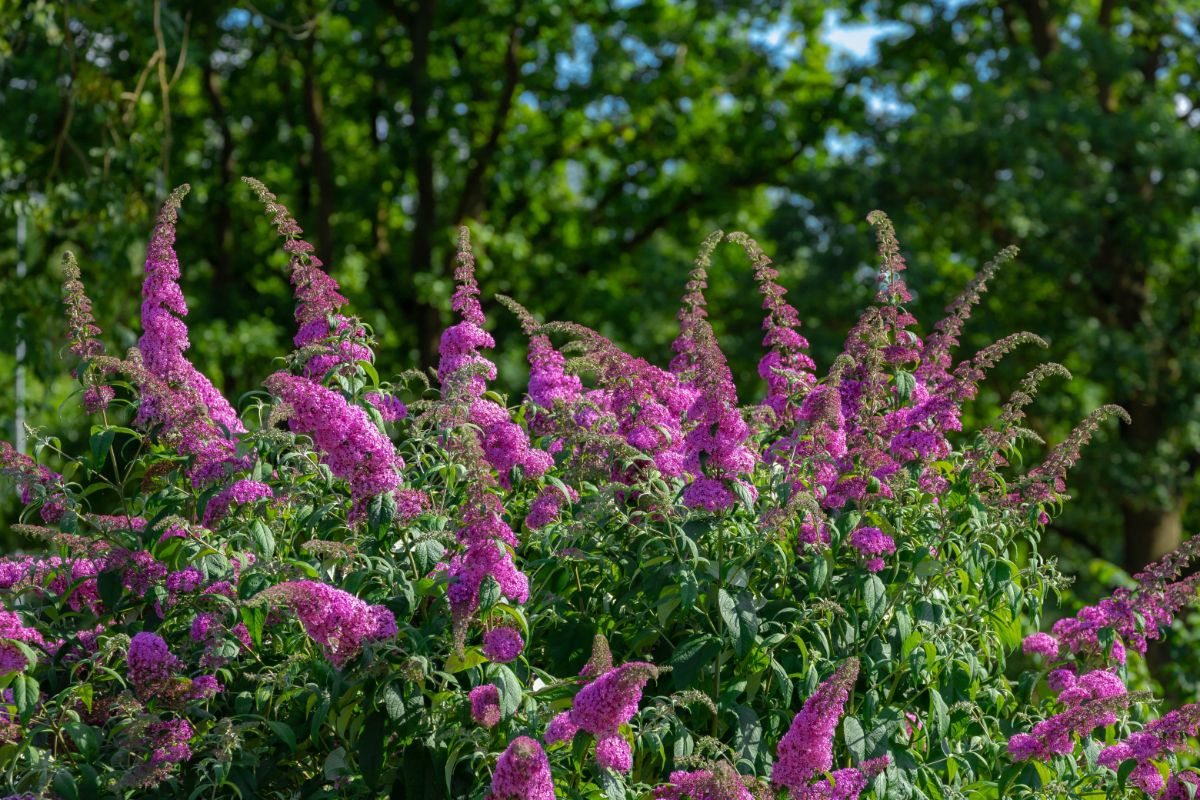
| Plant name: | Butterfly bush |
| Light requirements: | Full sun |
| Water requirements: | Moderate |
| Growing zone: | Zones 5 to 10 |
| Bloom time: | Mid-summer to early fall |
One of the most famous pollinator plants around, butterfly bushes have conical clusters of flowers that first appear in mid-summer and last through early fall. Always popular with butterflies and other insects, butterfly bush plants are particularly alluring to hummingbirds, which never seem to get enough of the plant’s sweet, sweet nectar! Butterfly bush flowers come in various shades of pink, purple, white, and blue, and they form the perfect complement to the plant’s silvery-green leaves.
Butterfly bushes range in size from tall, 5’ specimens to dwarf cultivars that stay around 2’ in height. Dwarf butterfly bushes are ideal container plants, while taller species will form a colorful backdrop to other pollinator favorites, like coneflowers and yarrow. One thing to note is that butterfly bushes are invasive in some areas, so you may want to think carefully about growing them if you live in an area where they may take over.
17. Blueberry (Vacciniumspp.)
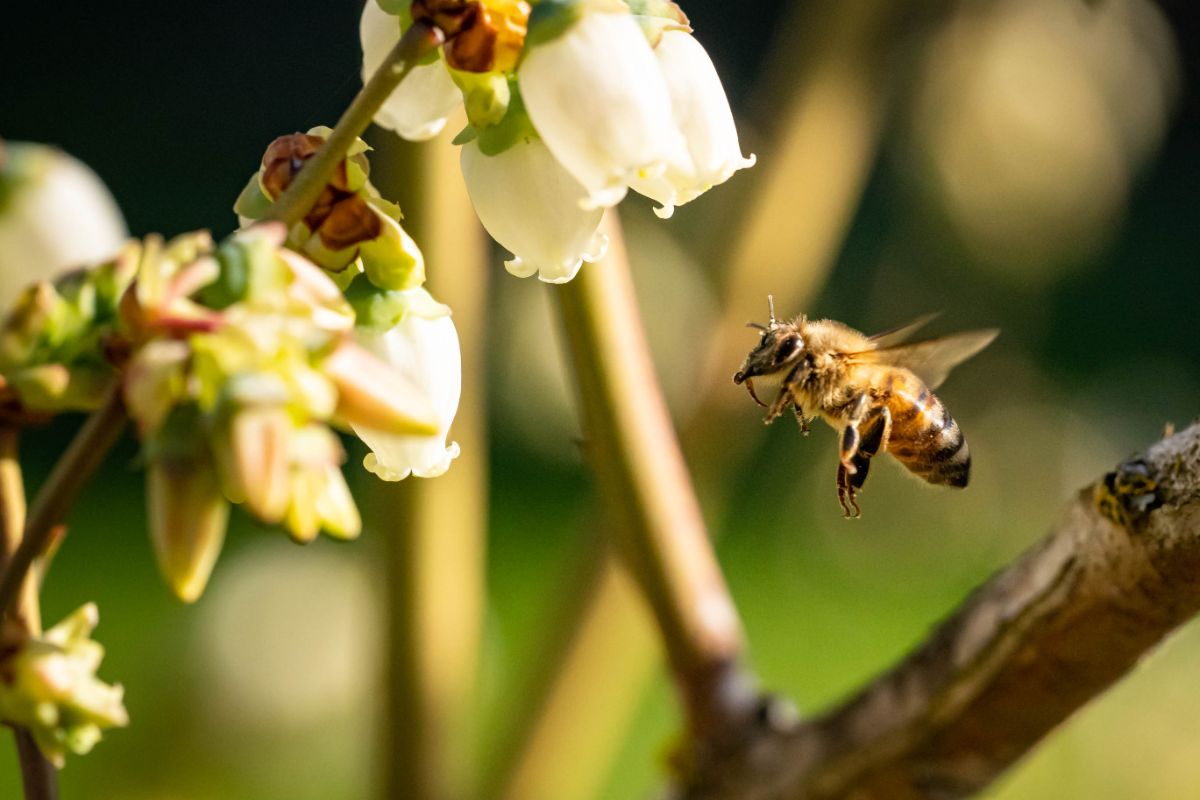
| Plant name: | Blueberry |
| Light requirements: | Full sun to part shade |
| Water requirements: | Moderate |
| Growing zone: | Zones 3 to 8, depending on a variety |
| Bloom time: | Spring |
Most of us think of blueberries as edible plants, but blueberries also have ornamental charm, and they make fabulous pollinator plants too. Blueberries bloom in spring, and their darling, bell-shaped flowers are always swarming with native bee species, including bumblebees. By summer, blueberry flowers mature into their succulent berries, which you’ll need to harvest early if you don’t want the birds to get them all!
Depending on the size of your garden, you can grow either high or lowbush blueberries, which have slightly different growing needs. Gardeners in warmer climates may also want to try out heat-loving blueberry varieties, like rabbiteye blueberries. For container gardens, lowbush or half-high blueberries are the best choices as they stay compact and won’t overwhelm small garden spaces.
18. Chokecherry (Prunus virginiana)
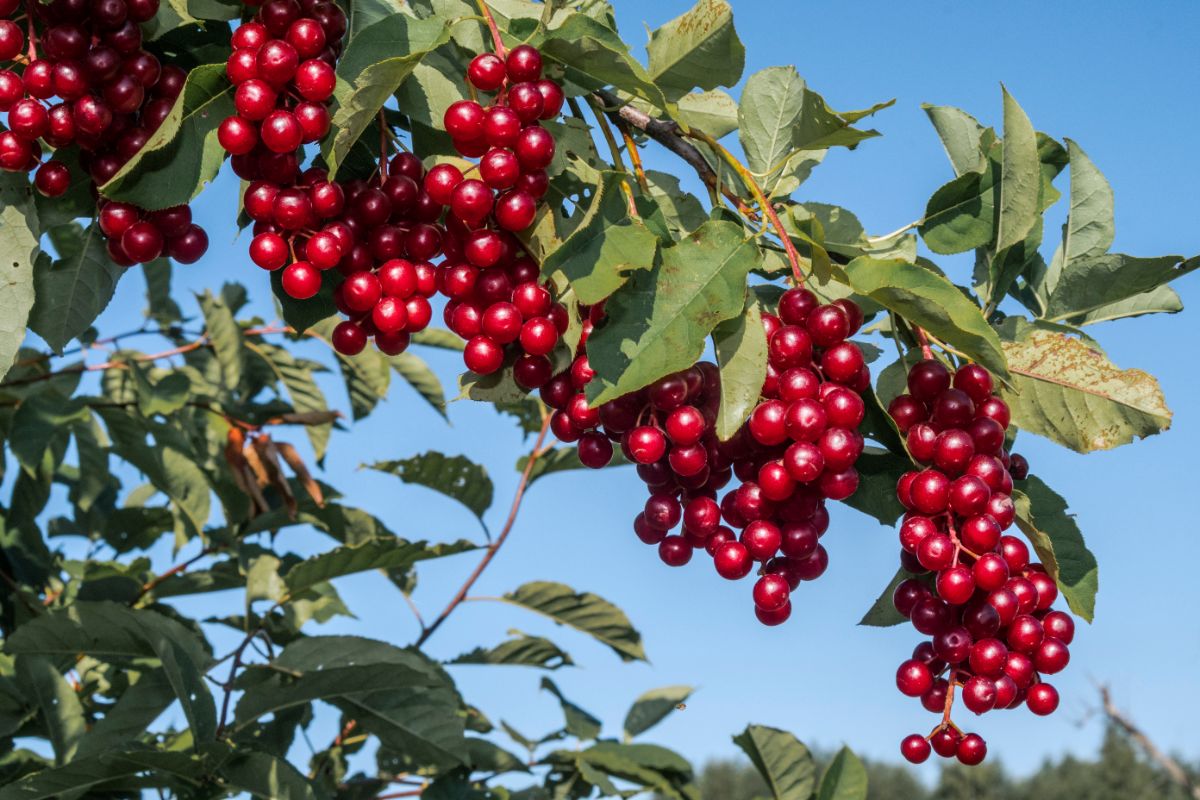
| Plant name: | Chokecherry |
| Light requirements: | Full sun to part shade |
| Water requirements: | Moderate to low |
| Growing zone: | Zones 2 to 7 |
| Bloom time: | Spring to mid-summer |
A powerful pollinator shrub, chokecherries are host plants for several different butterfly and moth species, including the eastern tiger swallowtail and the coral hairstreak. Chokecherries also bloom early in the season, but their white clusters of flowers are long-lasting and can continue to bloom through mid-summer. Later in the season, chokecherries yield a massive harvest of berries for wild birds and other wildlife.
Chokecherries are edible for humans, but they need to be cooked first as their taste is quite astringent. In fact, it’s the bitter flavor of chokecherries that earned them their name! If you have livestock on your property, you may want to think twice about growing chokecherries since they are toxic to ruminants like cattle and goats.
Summary

As with any other pollinator plants, native plants are generally the best choices for wildlife habitats as they offer more benefits for the pollinators and birds in your region. Shrubs with nectar or pollen-producing flowers, large seed heads, or autumn berries will provide a reliable food source for animals too. Additionally, shrubs with dense or evergreen leaves will serve as natural shelter and a spot for nesting, while known host plants are always useful as well!
On the other hand, you may want to stay away from plants with pollen-free or hybrid flowers as they offer fewer benefits for wildlife. Non-native shrubs, while beautiful, may not provide as many benefits for pollinators, and some non-native plants also have aggressive tendencies, which can make them unsuitable for some gardens. Keep these tips in mind when choosing shrubs for your landscape, and you’ll be able to construct a thriving pollinator garden with minimal fuss.
We hope this article on pollinator shrubs was useful! If you’d like to discover more tips on how to help wildlife, check out our guide on attracting fireflies to your backyard.

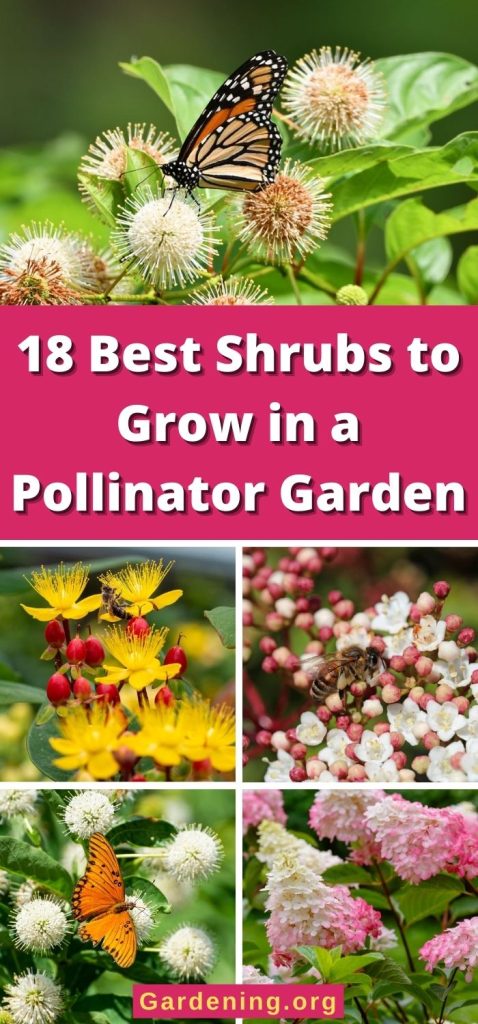
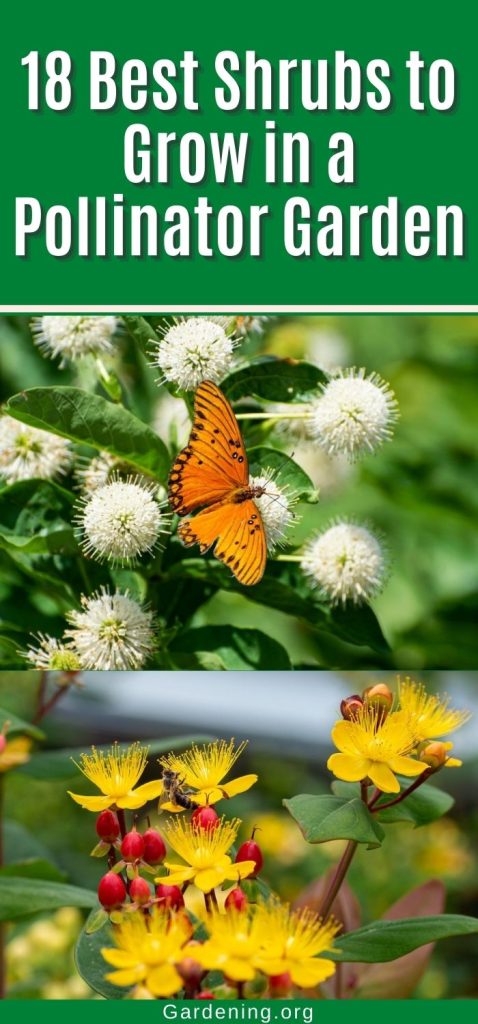
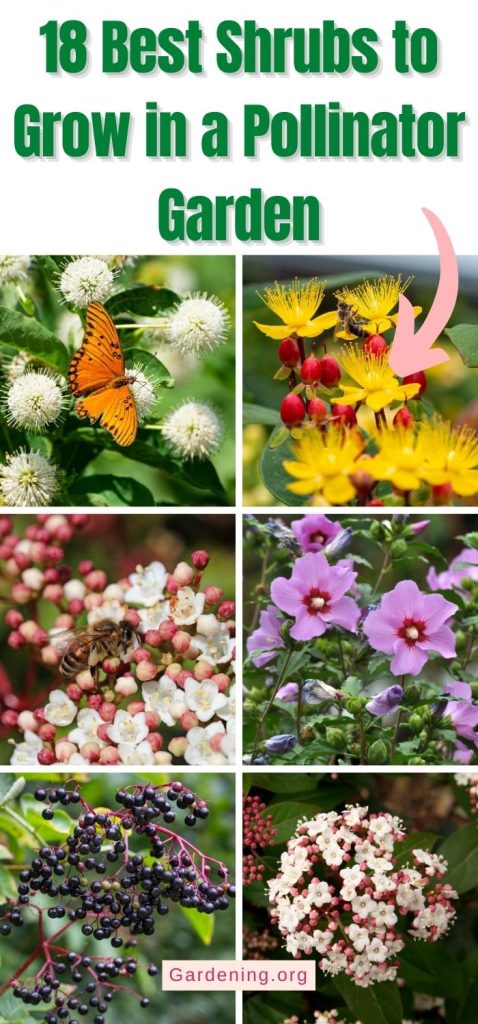
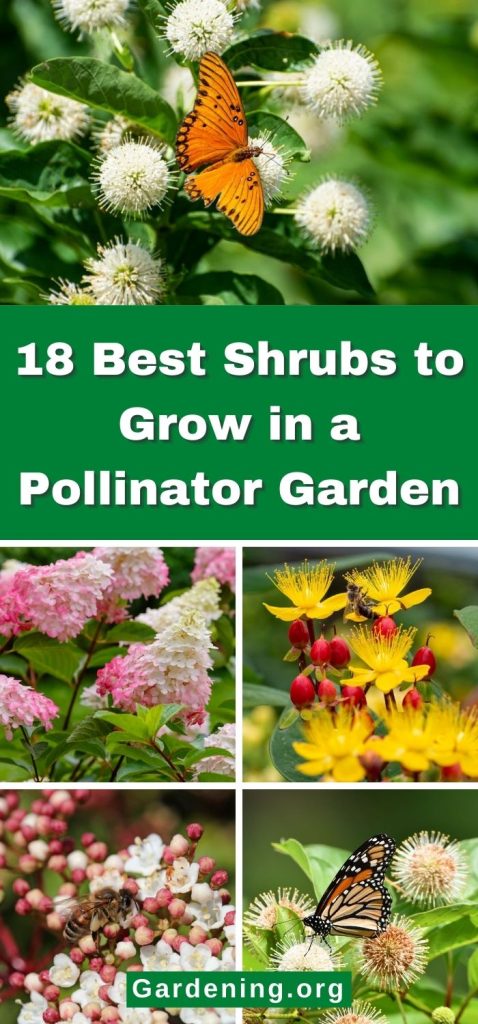
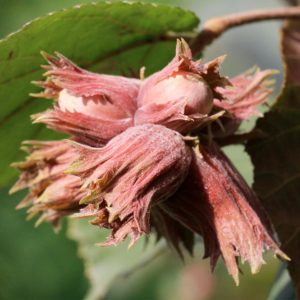

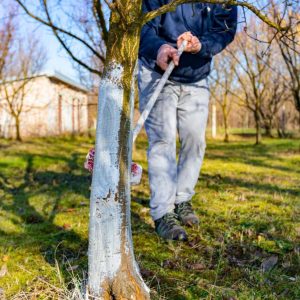
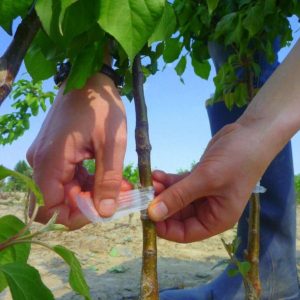
Sara J McMurray
Why are you listing non-native species and invasives such as buddleia in an article about shrubs that benefit pollinators? Our pollinators need native plants that evolved alongside them to provide the nutrients that they specifically need. Rose of Sharon is candy and serves no good purpose. Buttonbush, St John's Wort, Leadplant, and other natives provide a nutritious meal. Also, the native should be in its native form to be most valuable. While Ninebark, for instance, has been bred to uncountable colors, shapes and sizes, it is the true native with green leaves that is most beneficial to pollinators. And buddleia, along with burning bush, are known invasives that escape our lawns and take over wild areas, choking out the beneficial natives and ruining valuable habitats.
I love your content in general, but would love it a lot more if it were not only entertaining but also accurate and focused on positive changes we can make in our yards and gardens, rather than simply changes.
Mary Ward
What is invasive for one is not necessarily so for another. We always encourage readers to learn what is native or invasive or not in their area. Every plant came from somewhere!